Ixora can easily be identified by its attractive cluster of flowers and leathery leaves. But, it's not known to many, that along with being grown in gardens, this plant also has medicinal uses. Buzzle will deal with such facts, giving you information on how to grow Ixora plants, besides the care and problems related to it.

Did You Know?The leaves of the ixora plant are antiseptic in nature, and are used to treat wounds in some countries in Asia.Ixora is a tropical to semi-tropical shrub, native to South Asia, and is commonly grown in gardens. The plant belongs to the family Rubiaciae, and has large, shiny, leathery leaves, and small star-like flowers that grow in clusters at the branch tips. It is also known by several other names, like Flame of the Woods, Jungle Flame, Rangan, Ponna, Kheme, and so on. Each cluster may contain around 60 small flowers, and the plant has a rounded appearance. The flowers appear in a huge variety of colors, like red, pink, orange, and white. The plant, of which around 500 species exist, may grow to be as large as 12 feet tall, but most specimens hover around an average of 4 - 5 feet. It also bears round berries, having 1 - 2 seeds.
This plant undergoes flowering virtually throughout the year, and is evergreen in nature. It has become hugely popular in the southern states in the US, such as Florida, which share similar climatic conditions to its native South Asian countries, while it is not so common in the colder north. Its widespread use is fueled by the fact that it's relatively easy to maintain, and gives an attractive appearance to gardens. It is suited to dry, acidic soil, and can easily be grown in the USDA hardiness zones of 10 - 11, despite the fact that hardly anyone is aware of the name of the shrub. There are various aspects to taking care of this attractive plant, all of which are covered below.How to Plant an Ixora
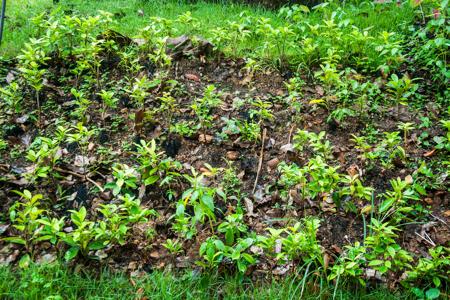
- Choose a site made up of well-drained soil and which is away from anything made of concrete. The site should be away from overhangs and downspouts as well.
- Loosen the top 10 - 12 inches of the soil and sieve out any pebbles, if present.
- If the soil is too clayey, mix organic materials like compost, peat moss, or composted cow manure to it in one-third proportion. This helps bring down its pH level.
- Take the potted Ixora and loosen the soil in the pot around the plant roots. Gently pull it out, ensuring that the roots are intact.
- Dig a hole in the soil that is a few inches wider than the root ball of the plant, and an inch or two deeper, but not wider than the pot.
- Place the plant in the pit and gently spread the roots outwards. Cover the plant base with soil, without covering the crown.
- Water with a root growth stimulator for enhanced growth.
- Pat the soil to fit the plant properly, but do not compact it too much.
- Add 3 inches of organic mulch, like compost or cut foliage to the root zone, beginning from the drip line (the edges where the water from the branch ends will hit the soil) but stopping well away from the stem. Mix it well with the top 10 - 12 inches of the soil. This mulch will retain moisture, and avoid nematodes and fungal growth.
- Water the plant regularly to help the roots grow and entrench themselves.
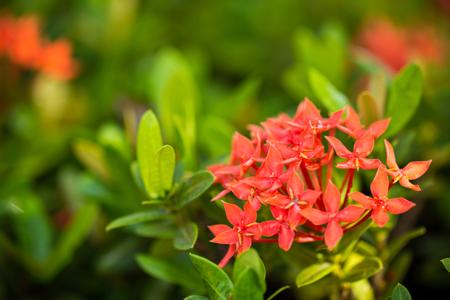
Caring for Your PlantLightBeing tropical in origin, the plant requires bright sunlight and cannot handle frosty weather, though some varieties can. In extreme heat, it is advised to grow the plant in slight shade. Potted plants should be shifted to partial shade during the heat of the day. The plant develops more attractive colors when exposed to adequate sunlight.TemperatureThe plant thrives in temperatures ranging from 59°F to 70°F. These plants will not survive in freezing temperatures.FertilizerBeing suited to acidic conditions, this plant will require more fertilizer. Fertilize once every two weeks. This is to be done thrice a year, in March, June, and October. Use a quality granular, N-P-K fertilizer (nitrogen-phosphorus-potassium), with a higher concentration of nitrogen, after diluting it to half. This will help in good development of the flower buds, resulting in regular blooming. Nitrogen helps in leaf growth, phosphorus in flowering, and potassium imparts vigor. Using an N-P-K rWatering

In warm weather, watering should be regular. During the winters, water only when the soil appears dry. It's a good idea to water the plant till the top 0.4" of soil is moist. Then allow it to dry, before watering again. Over-watering can cause serious damage.SoilIxora requires acidic soil. If the soil becomes alkaline, add acidic fertilizers. The soil should be moist, rich in organic content, well-drained, and loose. The plant can handle salinity to some extent.Pruning
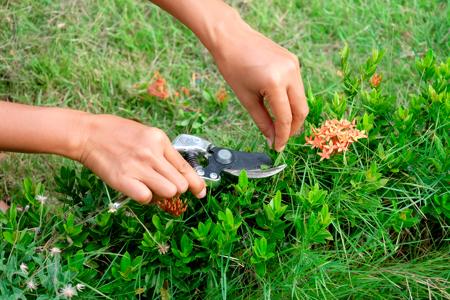
Prune the plant in early spring when new shoots are formed. The plant has a cluster of flowers growing at the tips. Avoid repeated pruning and pruning mature branches, as this will cut the flower buds, leading to lesser flowers. Sterilize the pruning equipment with bleaching solution between cuts to reduce the risk of infection.MulchingApply mulch regularly up to 3 - 4", making sure it does not extend and pile-up on the stem, as this can attract root worms. Besides retaining water, this mulch layer also keeps competing weeds, fungi, nematodes, and root parasites at bay, along with providing quality nutrients.
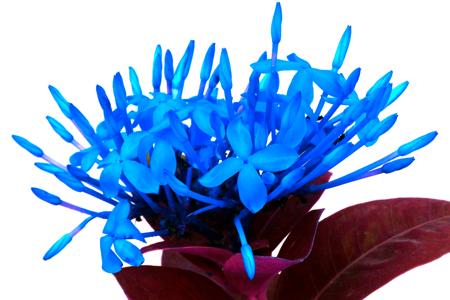
PropagationUsing Stem Cuttings
- Take a 2 - 3" long, mature stem cutting in the warm season. The bottom of the cut should be oblique, and it should be made just below a leaf. Cut off that leaf.
- Place the lower end in a pot containing an equal mixture of peat moss and perlite, preferably after dipping in a rooting hormone. Cover it with polythene.
- Allow the roots to develop for 3 - 4 weeks. After that, gradually uncover the polythene over a 2-week period, to help the plant adjust to the less humid room atmosphere.
- Start watering the plant, along with allowing the soil to dry in between. Apply liquid fertilizer.
- After 2 ½ to 3 months, transfer the plant to a larger pot containing potting soil for adult plants.
Using Seeds
- Pluck the berries off the plant and remove all the pulp.
- Soak the seeds overnight.
- Plant in a pot containing seed-starter mix, and moisten the soil. Cover it with polythene.
- Transfer to a well-lit area when the seeds germinate.
Common Problems Faced by this PlantChlorosisThe leaves start yellowing if the soil becomes alkaline or is deficient in minerals. This happens when the plant is grown near concrete pathways, since concrete causes the surrounding soil to become alkaline. Use an acid-forming fertilizer to reduce the soil pH. These plants may also fall victim to the deficiency of minerals like iron and magnesium. Iron deficiency affects the young leaves, while magnesium deficiency affects the mature ones. Treat this by applying a diluted solution (½ to 1 teaspoon in 1 gallon water) of micronutrient foliar spray on the leaves, as nutrients are well-absorbed by the leaves when the soil is alkaline.PestsAphids, scale insects, spider mites, and mealy bugs may adhere to the leaf bottom and suck the plant sap, leaving behind their waste, which causes mold growth. This is visible in the form of sooty or greasy black fungus. Treat this by using insecticidal soap or horticultural oil spray, which causes the mold to be shed off in time. Ensure to apply this late in the day when there is no sunlight, so as to prevent the leaves from getting burnt. Fungi can also be dealt with by overhead watering.Other ProblemsThe plant may not bloom when light is not sufficient. Move to a better-lit location. Also, the leaves may show brown edges and the buds may shrivel without blooming. This is due to less moisture. Increase the humidity using a humidifier or putting the pot on a tray of wet pebbles.UsesGardening
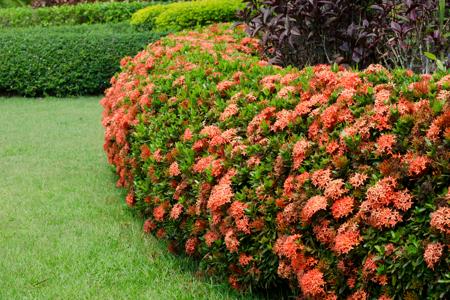
These plants are used as hedges for foundation planting, screens as a background plant, in greenhouses, in containers, bonsai, as edging, and in various landscape designs.Other UsesFor Hindu worship, the flowers, leaves, and roots are used in the traditional Indian medicine system of Ayurveda, to treat rheumatism, wounds, diarrhea, and fever, and the fruits are eaten as food. Ixora, being tropical in origin, cannot handle cold weather. That, coupled with its preference for acidic soil, sums up everything related to the care of this plant.






 Did You Know?The leaves of the ixora plant are antiseptic in nature, and are used to treat wounds in some countries in Asia.Ixora is a tropical to semi-tropical shrub, native to South Asia, and is commonly grown in gardens. The plant belongs to the family Rubiaciae, and has large, shiny, leathery leaves, and small star-like flowers that grow in clusters at the branch tips. It is also known by several other names, like Flame of the Woods, Jungle Flame, Rangan, Ponna, Kheme, and so on. Each cluster may contain around 60 small flowers, and the plant has a rounded appearance. The flowers appear in a huge variety of colors, like red, pink, orange, and white. The plant, of which around 500 species exist, may grow to be as large as 12 feet tall, but most specimens hover around an average of 4 - 5 feet. It also bears round berries, having 1 - 2 seeds.
Did You Know?The leaves of the ixora plant are antiseptic in nature, and are used to treat wounds in some countries in Asia.Ixora is a tropical to semi-tropical shrub, native to South Asia, and is commonly grown in gardens. The plant belongs to the family Rubiaciae, and has large, shiny, leathery leaves, and small star-like flowers that grow in clusters at the branch tips. It is also known by several other names, like Flame of the Woods, Jungle Flame, Rangan, Ponna, Kheme, and so on. Each cluster may contain around 60 small flowers, and the plant has a rounded appearance. The flowers appear in a huge variety of colors, like red, pink, orange, and white. The plant, of which around 500 species exist, may grow to be as large as 12 feet tall, but most specimens hover around an average of 4 - 5 feet. It also bears round berries, having 1 - 2 seeds.
 Caring for Your PlantLightBeing tropical in origin, the plant requires bright sunlight and cannot handle frosty weather, though some varieties can. In extreme heat, it is advised to grow the plant in slight shade. Potted plants should be shifted to partial shade during the heat of the day. The plant develops more attractive colors when exposed to adequate sunlight.TemperatureThe plant thrives in temperatures ranging from 59°F to 70°F. These plants will not survive in freezing temperatures.FertilizerBeing suited to acidic conditions, this plant will require more fertilizer. Fertilize once every two weeks. This is to be done thrice a year, in March, June, and October. Use a quality granular, N-P-K fertilizer (nitrogen-phosphorus-potassium), with a higher concentration of nitrogen, after diluting it to half. This will help in good development of the flower buds, resulting in regular blooming. Nitrogen helps in leaf growth, phosphorus in flowering, and potassium imparts vigor. Using an N-P-K rWatering
Caring for Your PlantLightBeing tropical in origin, the plant requires bright sunlight and cannot handle frosty weather, though some varieties can. In extreme heat, it is advised to grow the plant in slight shade. Potted plants should be shifted to partial shade during the heat of the day. The plant develops more attractive colors when exposed to adequate sunlight.TemperatureThe plant thrives in temperatures ranging from 59°F to 70°F. These plants will not survive in freezing temperatures.FertilizerBeing suited to acidic conditions, this plant will require more fertilizer. Fertilize once every two weeks. This is to be done thrice a year, in March, June, and October. Use a quality granular, N-P-K fertilizer (nitrogen-phosphorus-potassium), with a higher concentration of nitrogen, after diluting it to half. This will help in good development of the flower buds, resulting in regular blooming. Nitrogen helps in leaf growth, phosphorus in flowering, and potassium imparts vigor. Using an N-P-K rWatering In warm weather, watering should be regular. During the winters, water only when the soil appears dry. It's a good idea to water the plant till the top 0.4" of soil is moist. Then allow it to dry, before watering again. Over-watering can cause serious damage.SoilIxora requires acidic soil. If the soil becomes alkaline, add acidic fertilizers. The soil should be moist, rich in organic content, well-drained, and loose. The plant can handle salinity to some extent.Pruning
In warm weather, watering should be regular. During the winters, water only when the soil appears dry. It's a good idea to water the plant till the top 0.4" of soil is moist. Then allow it to dry, before watering again. Over-watering can cause serious damage.SoilIxora requires acidic soil. If the soil becomes alkaline, add acidic fertilizers. The soil should be moist, rich in organic content, well-drained, and loose. The plant can handle salinity to some extent.Pruning Prune the plant in early spring when new shoots are formed. The plant has a cluster of flowers growing at the tips. Avoid repeated pruning and pruning mature branches, as this will cut the flower buds, leading to lesser flowers. Sterilize the pruning equipment with bleaching solution between cuts to reduce the risk of infection.MulchingApply mulch regularly up to 3 - 4", making sure it does not extend and pile-up on the stem, as this can attract root worms. Besides retaining water, this mulch layer also keeps competing weeds, fungi, nematodes, and root parasites at bay, along with providing quality nutrients.
Prune the plant in early spring when new shoots are formed. The plant has a cluster of flowers growing at the tips. Avoid repeated pruning and pruning mature branches, as this will cut the flower buds, leading to lesser flowers. Sterilize the pruning equipment with bleaching solution between cuts to reduce the risk of infection.MulchingApply mulch regularly up to 3 - 4", making sure it does not extend and pile-up on the stem, as this can attract root worms. Besides retaining water, this mulch layer also keeps competing weeds, fungi, nematodes, and root parasites at bay, along with providing quality nutrients. PropagationUsing Stem Cuttings
PropagationUsing Stem Cuttings These plants are used as hedges for foundation planting, screens as a background plant, in greenhouses, in containers, bonsai, as edging, and in various landscape designs.Other UsesFor Hindu worship, the flowers, leaves, and roots are used in the traditional Indian medicine system of Ayurveda, to treat rheumatism, wounds, diarrhea, and fever, and the fruits are eaten as food. Ixora, being tropical in origin, cannot handle cold weather. That, coupled with its preference for acidic soil, sums up everything related to the care of this plant.
These plants are used as hedges for foundation planting, screens as a background plant, in greenhouses, in containers, bonsai, as edging, and in various landscape designs.Other UsesFor Hindu worship, the flowers, leaves, and roots are used in the traditional Indian medicine system of Ayurveda, to treat rheumatism, wounds, diarrhea, and fever, and the fruits are eaten as food. Ixora, being tropical in origin, cannot handle cold weather. That, coupled with its preference for acidic soil, sums up everything related to the care of this plant.